Anatomy Of A Scene - Nightbreed (Opening)
A scene often changes radically between first conception in the writer's mind and its final publication or public airing. This is perhaps especially so in the melting pot of collaborative effort on a movie and the sequence we've chosen below charts the progress from page to screen of the opening moments of Nightbreed, from novel to draft script to shooting script to the editing suite...
The opening sequence establishes the tone and epic sweep of a movie intended to showcase and celebrate 'otherness' and the beauty of the monstrous.
Cabal
The first incarnation of the story of Aaron Boone and his place within the Nightbreed is as the novel, Cabal. This was written in 1987
and published in 1988 as a standalone novel in the UK and packaged with four stories from volume 6 of the Books of Blood in the
US.
The book opens with Aaron Boone's desperate reflections on his fragile mental state and the course of his longed-for recovery under the
watchful eye of his 'rock', Doctor Decker.
Of all the rash and midnight promises made in the name of love none, Boone now knew, was more certain to be broken than:
'I'll never leave you'.
What time didn't steal from under your nose, circumstance did. It was useless to hope otherwise; useless to dream that the world
somehow meant you good. Everything of value, everything you clung to for your sanity would rot or he snatched in the long run,
and the abyss would gape beneath you, as it gaped for Boone now, and suddenly, without so much as a breath of explanation,
you were gone. Gone to hell or worse, professions of love and all.
His outlook hadn't always been so pessimistic. There'd been a time - not all that long ago - when he'd felt the burden of his
mental anguish lifting. There'd been fewer psychotic episodes, fewer days when he felt like slitting his wrists rather than
enduring the hours till his next medication. There'd seemed to be a chance for happiness.
It was that prospect that had won the declaration of love from him; that: 'I'll never leave you,' whispered in Lori's ear as
they lay in the narrow bed he'd never dared hope would hold two. The words had not come in the throes of high passion. Their
love life, like so much else between them, was fraught with problems. But where other women had given up on him,
unforgiving of his failure, she'd persevered: told him there was plenty of time to get it right, all the time in the world.
I'm with you for as long as you want me to be, her patience had seemed to say.
Nobody had ever offered such a commitment; and he wanted to offer one in return. Those words; 'I'll never leave you'. Were it.
The memory of them, and of her skin almost luminous in the murk of his room, and of the sound of her breathing when she finally
fell asleep beside him - all of it still had the power to catch his heart, and squeeze it till it hurt.
He longed to be free of both the memory and the words, now that circumstance had taken any hope of their fulfilment
out of his hands. But they wouldn't be forgotten. They lingered on to torment him with his frailty. His meagre comfort was that
she - knowing what she must now know about him, - would be working to erase her memory; and that with time she'd succeed.
He only hoped she'd understand his ignorance of himself when he'd voiced that promise. He'd never have risked this pain if he'd
doubted health was finally within his grasp.
Dream on!
Decker had brought an abrupt end to those delusions, the day he'd locked the office door, drawn the blinds on the Alberta
spring sunshine, and said, in a voice barely louder than a whisper:
'Boone. I think we're in terrible trouble, you and I.'
Cabal - 1987
On that day, having drawn the blinds, Decker opens Boone's eyes to a series of horrific murder scene photos, the victims hacked to viciously to death with multiple stab wounds. Decker tells his patient that he has spoken in his trance-like sessions about committing crimes - murders like the butchery represented in the photos. He further tells him that he now believes Boone to have truly committed these acts...
This scene is pivotal in the movie, with Decker's wilful misinformation driving Boone to seek out the mythical refuge for 'monsters', Midian, abondoning Lori's love for a self-imposed exile with the Nightbreed.
However, as a cinematic opening for a movie, a different approach was required...
Screenplay
Clive had planned to adapt Cabal into a screenplay early in its writing. Renamed Nightbreed, the movie was the first of a planned three-picture deal with Morgan Creek alongside a planned adaptation of Son of Celluloid and a Nightbreed sequel.
"Son of Celluloid is the second picture we'll make together, and the third will hopefully be Nightbreed 2. When Morgan Creek bought the film rights to Cabal they insisted on a more commercial title. They thought it didn't mean anything and they could be right. Who knows?"
Clive Barker's Nightbreed
By Alan Jones, Cinefantastique, Vol 20 Nos 1 & 2 (double-issue), November 1989
"One of the things I love about making a movie from
something I've written is the pleasure of being able to reinvent your
imagination: you've done it once, you know the way it looked when you
wrote it, and then you reinvent it entirely. Nightbreed doesn't look
the way I imagined it when I was writing Cabal. It has turned out to
be much larger in scale than I originally anticipated, but it's still
manageable for someone like me who is only making his second picture.
"The book is about Boone and his journey; the movie is about the
Nightbreed, this hidden tribe of mythological beings, shape-changers
and strange people who come from the Old Country of the imagination."
Nightbreed Presskit
By [ ], 1990
"I've always loved monsters. I think there's a corner of all of us that envies their powers and would love to live forever, or to fly, or to change shape at will. So, when I came to make a movie about monsters, I wanted to create a world we'd feel strangely at home in. I called it Midian. An underground city peopled with creatures from our darkest fantasies: things that feed on blood; things that avoid the light of day; things repulsive and fascinating; forbidden souls hiding from their cruellest enemy - man.... All of us, behind the camera and in front, had the same intention - to make Nightbreed a film like no other, flipping all the conventions of the horror movie, plunging you into a world of insanity and miracles where dead men can be heroes and monsters beautiful, where the only place of refuge is the most forbidden place on earth: Midian - the home of the Nightbreed."
Introduction to Nightbreed
By Clive Barker, Nightbreed US Video, 1991
"Perhaps the story-form that fascinates me most is that of the lost or wandering tribe. I treated it first in Weaveworld, a book about the Seerkind, who still possessed a holy magic in a secular and rationalist world. Now, in Nightbreed I'm creating another tribe, but a very different one. The Kind was an essentially benign species. The Breed are not. They're the monstrous flip side of the coin; a collection of transformers, cannibals and freaks. Their story, as set down in Cabal, and now re-envisioned in Nightbreed, is in a long tradition of night-quests: a visit by members of our species into the haunted underground to confront buried mysteries. Those mysteries bite. Several of the Breed have an appetite for human meat. Some are more bestial than human; others have a touch of the Devil in them, and are proud of the fact. To set foot in their domain is to risk death at their hands. But it is also a chance to see the lives of Naturals like ourselves from another perspective. The workings of the world seem a little more preposterous through the eyes of monsters. The Breed have been persecuted in the name of loving God; nearly exterminated by people who have envy in their hearts as much as hatred."
Introduction: Nightbreed
By Clive Barker, Clive Barker's Nightbreed - The Making of the Film, 1990
An early idea had been to open the movie with a sequence of moon imagery and a series of voiceovers with both hard science and popular fable about the moon, setting up the narrative for the Tribes of the Moon, but by the time of Clive's 14 September 1988 first draft screenplay, he had decided to explicitly contrast the night with the day. On the cover of his working draft, shown below, he sketched out thoughts for the sun and moon, interwined with the title of the movie.
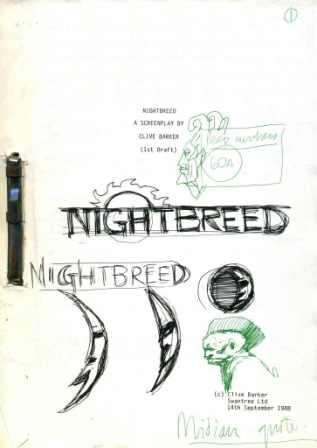
The early drafts of the screenplay evoked the setting sun and, as it sets, the emergence of the breed of the night...
FADE IN:
1. TITLE SEQUENCE
The SCREEN blazes orange, over which the first credits appear. Then we PULL OUT. The blaze is the setting sun, sinking below
a rural horizon. Once it disappears, darkness rules. And luminous against the blackness:
Clive Barker's NIGHTBREED
As the rest of the TITLES run we are offered glimpses of fantastic monsters: erotic, mysterious, terrifying, beautiful. Music, a mystic
theme: slow, incantatory.
The last CREATURE in the parade turns to glance at us. As it does so a flash of brilliant sparks leaps across the SCREEN,
burning out the night image with light. The image becomes a CLOSE UP of a welding job...
2A. INT. GARAGE. CALGARY
Sparks fly from the welding. We PAN UP to the worker, in overalls. It is BOONE. His face is partially masked. We TRACK
AWAY from him, past another worker, EDDIE, towards the door of the garage. Appearing in it, an attractive woman in her
mid-twenties, LORI.
Second draft - pink pages, revised 2 February 1989
Storyboards
Principal photography started at Pinewood Studios on 6 March 1989 for a scheduled nine-week shoot.
Clive prepared visual material as storyboards to support a revised opening with the camera panning down from the opening shot of the setting sun, down and deeper down through the earth to Midian. He supported these visuals with additional text to describe the opening in more detail.
Titles
The Sequence begins above ground, with the setting sun, then moves underground down through a multiplicity of images of figures set in the graffiti-scrawled walls of Midian. Some of these figures are partially transformed into monsters, but none of them actually resemble Breed we'll see in the picture. They are teasers: subtly erotic and hallucinatory, moving in the rock like living fossils. The sequence is a series of lap dissolves, the downward motion never stopping, each image held only long enough for the audience to half-grasp it before it's gone. The deeper we go, the more we venture into regions of wild visions, fire and - finally - profound darkness. In that darkness we find a face we'll later recognise as Boone, whose awakening ignites the screen and our story...
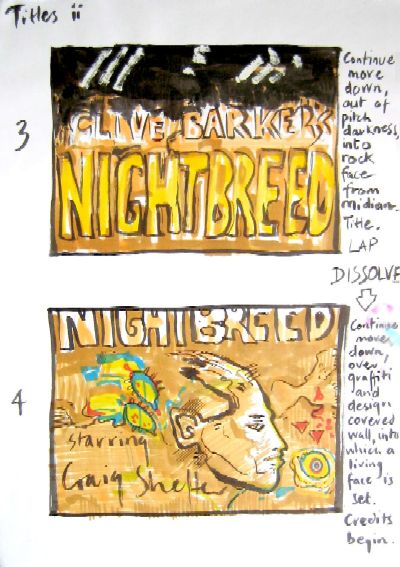
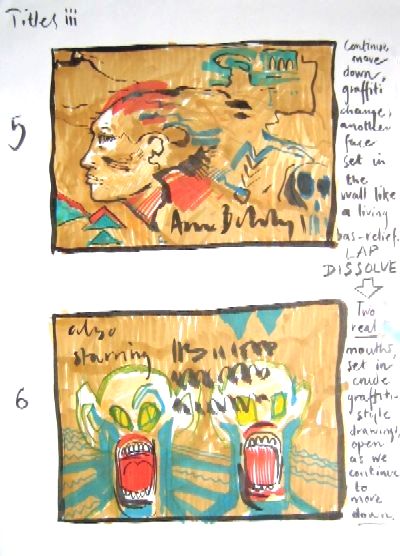
Storyboards by Clive Barker - 1989
Mid-Production
Writing the introductory notes to the movie's "making of" book, Clive reflected on the development of scenes under the myriad of contributing influences on a production.
"Movies change; and change; and change.
"The images that first play on the screen inside your skull as you set pen to paper are subject to constant configuration.
First you cast the faces to go with the characters, and costume them, and make them up; then the actors add their own
embellishments to the dialogue, and the lighting cameraman has his contribution, and the set dresser his, and so on and so forth.
But that's only the beginning. The image, though fixed on celluloid, is still malleable in countless ways. The editor, placing one
action beside another, can change the significance of each; can re-order dialogue, making new sense of old ideas. The optical
effects men may create paintings that will put cities where there were none before, and just as magically remove them. The labs
can make noon into twilight, or vice versa. Then, sound: another world of significance, transforming the way we perceive the picture
on the screen; and music, to signal our responses.
"What at first may seem the most immutable of media is in fact capable of being transformed at dozens of stages on its way from
screenplay to screen.
"As both a writer and a director I am involved in the full spectrum of these processes. Inevitably, during the long, long trail from
word to premiere, spirits soar and dive, ideas one day seeming God-given and the next rejected as hellish; decisions becoming
badges of honour or yokes.
"Somewhere half way through this journey I'm setting these words on paper. Maybe the profoundest doubts about this project
are past, and I'm finally on safe ground, believing we've made a good movie: but I'm laying no bets. We've still got another two
weeks of shooting to do, much of it related to special effects; that material has then to be cut into the picture. Mattes have yet to
be painted, cells animated, titles created, music composed..."
Introduction: Nightbreed
By Clive Barker, Clive Barker's Nightbreed - The Making of the Film, 1990
Production Artwork
With the film's principal photography nearing completion Ralph McQuarrie, the concept artist famous for his Star Wars work with George Lucas amongst other material, was brought into the production team to paint mattes for the Necropolis sequences and to work on a mural of the Breed's history.
"Ralph has designed the history of the Breed in symbolic
form, painted on an enormous mural. So he's not just the artist, he's
actually now the chronicler of the Breed's history, springing as they
do from the same seed as we naturals - the naturals being the people
who like the Sun and the Breed being the people who rather prefer the
Moon. Ralph is now laying out the whole history; the back story, the
wars...
"Fox saw the picture at the weekend and what they talked about was
the mythology. They see it as a very, very dark Star Wars, and what
Joe Roth, who's heading up Fox, said was that they wanted to put out
a trailer which was basically The Myth trailer. Put out a long trailer,
introduce the mural chamber, use stuff from the picture to present the
fact that this movie was going to take the audience - if you think of
Star Wars as being a trip into space - this is a trip into the earth
to meet the dead stuff and the almost dead stuff, and the stuff which
wishes it could be dead but can't quite be dead; the Breed, in other
words. I think what Ralph has been able to lend to the project is a
sense of that mythology."
The Breed : Source Of The Soul
By John Gilbert, Fear, No 10, October 1989
Having designed the history of the Breed, Ralph McQuarrie painted the tale as a mural acoss a sixty-foot space on the set at Pinewood Studios. The resultant artwork features heavily the opening credits sequence as the Breed's backstory and immediate future are outlined.
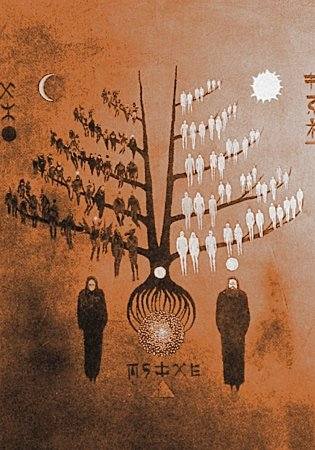
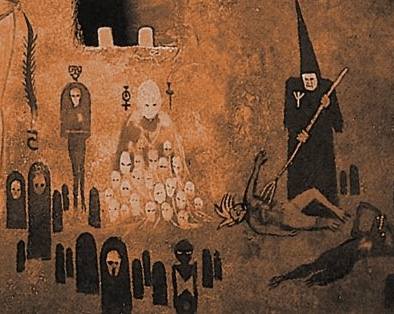
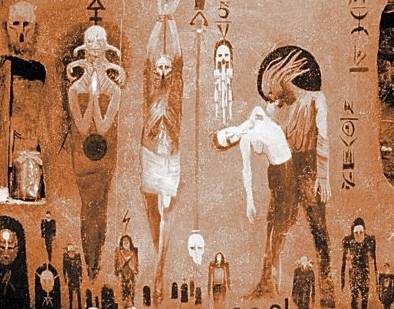
Ralph McQuarrie : "It's important for me to feel that each thing I put up there is done in a certain spirit. The mural is a chronicle, a kind of catalogue of these creatures and the normals who are in the process of becoming the Breed."
The Breed : Source Of The Soul
By John Gilbert, Fear, No 10, October 1989
Ralph McQuarrie : "I didn't have time to read the book. The film was pretty much done when I got here. I saw the film a week or so ago, and I loved it..."
Barker And McQuarrie
By [ ], Starburst Yearbook, Winter Special 1989/90
"What I think Ralph brought to the team is a scale to his imaginings - which are coming through the matte paintings, the murals, through some of the creatures which he helped me develop - which are really making the movie even more epic than it was."
Barker And McQuarrie
By [ ], Starburst Yearbook, Winter Special 1989/90
Ralph McQuarrie :
"The interesting thing about this film is that the monsters really aren't horrible. And you come away from the film thinking, 'Gee,
this was a wonderful thing... I just love this place, and I loved the monsters.' I've sort of evolved a philosophy through my experience
that sort of tells me nothing in the universe is harmful... What you offer the audience in a picture like Nightbreed is a lot of contrast,
which becomes very interesting, very satisfying and very entertaining.
"So the paintings want to depict the, you know, flayed flesh and the agony and the beauty of the Breed - and the experience of
being... The painting wants to be kind of crude, but ultimately elegant when you look at it."
Barker And McQuarrie
By [ ], Starburst Yearbook, Winter Special 1989/90
Final Script
With Ralph McQuarrie's artwork complete, a revised opening sequence was scripted, utilising the footage of the mural and of the Breed outside the gates of Midian.
SCENES 1 to 2J DELETED
2K TITLES SEQUENCE
Darkness. Then, a burst of sparks from a bowl held in a scaly hand.
The light shows us a mural. We start to move along the wall. First we
see stars and planets, painted in a primitive, stylized fashion on
bare rock. A voice on the track speaks softly to us.
VOICE: We did not always live in hiding.
We have come to the image of a huge family tree, which springs from
a single seed but divides into two separate halves. On the left,
ruled by the moon, the branches blossom into extraordinary creatures.
On the right, by sunlight, the branches end in ordinary human beings.
VOICE: Once we roamed the earth freely, born to possess the night as
Naturals are born to the day. For we are the tribes of the moon. We are the Nightbreed.
Upon the word NIGHTBREED the title comes up on the screen, against
the image of a moon painted on the wall.
2L EXT. REEDS NIGHT
Cut to a real moon. Then cut wide to a moonlit landscape, through which the camera careens madly. The soundtrack, which was lush and almost sacred in the mural chamber, erupts in a Tribal rhythm. We glimpse creatures in the darkness, moving through the reeds. They are barely more than silhouettes. We see teeth, and gleaming eyes; glimpses of naked, patterned flesh. Only glimpses.
2M INT. MURAL CHAMBER
Cut back to the mural chamber. Now we have moved away from the tree
to a more brutal scene. A symbolic representation of a great
apocalyptic war between Naturals and Breed. Terrible scenes of
destruction.
VOICE: But the Naturals made war on us. They feared us for our
strength. They envied our powers. They called us monsters, killing us
by whatever means their malice could invent, finding in each of us
our particular vulnerability.
We are scanning scenes of that war. A breed being staked like a
vampire. Another being shot like a werewolf. Another exposed to
sunlight.
VOICE: None of us was safe. The tribes of the moon dwindled. Our
gods were slaughtered, our homes destroyed. It was the Apocalypse.
2N EXT. NECROPOLIS WALL AND GATES
Cut back to the landscape. The clouds roll above the heads of the creatures heading through the reeds. We see their destination now. A huge wall, with gates.
2P INT. MURAL CHAMBER
And back to the mural chamber, and a final scene. The gates we've
just seen are in the painting. Looking over them, calling the Breed
in, is a vast indistinct form: that of BAPHOMET. His eyes burn; his
arms are open in welcome.
VOICE: Only one of our Gods survived the holocaust. Baphomet.
Wounded and near to death, he summoned us, the last of the last, into
hiding. Into Midian, where we wait now. The battle is over but not
the war. There will come a saviour.
Now we've moved beyond the image of the gate into a new patch of
wall on which the pictures are only vague sketches. We can interpret
some of the images nevertheless, though the figures are faceless. A
man with a bloody hole in the
middle of his chest. A man wearing a mask like a skull. We linger on
a faceless figure.
VOICE: His name is Cabal. He will lead and give us back the Night.
We are the tribes of the moon. We are the Nightbreed.
The titles end.
2Q EXT. NECROPOLIS WALL AND GATES
Cut back to the landscape. Now we are at the gates, and all but one of the
creatures slips through and away into the mist. Only one, a beautiful,
ferocious female called SHUNA SASSI remains, turning to look at us.
She beckons.
SHUNA: Come...
The camera retreats from her.
SHUNA: Will you not come?
Now the last of the creatures, the DRUMMER, takes her by the arm,
snatching her away through the gates. As she disappears, the camera
follows again, stopping at the gates themselves, which close with an
unearthly din.
CUT TO:
2R. INT. LORI'S APARTMENT NIGHT
C.U. on BOONE, closed eyes. He is dreaming. His gaze roves beneath
his lids.
LORI's lips come into shot kissing first his eyes and then travelling
down his face to his mouth.
LORI: Boone... wake up.
BOONE's eyes flicker open.
Shooting script - green pages, revised 25 August 1989
Final Editing
The opening of the finished movie utilises the same general structure as the 25 August draft but the narrative voiceover explaining the relationship between the Breed and the Naturals was dropped, as was Shuna Sassi's dialogue. The series of cuts between the mural chamber and the reeds in front of Midian was also replaced by a more linear sequence with the final edited version having a dreamy crawl across the mural accompanied by Danny Elfman's score followed by a frenetic series of shots of the Breed before the close-up on Boone's face opens the movie's dialogue and we're off and running...
Click here for Anatomy of Nightbreed's closing scenes
Click here for Anatomy of two of Nightbreed's deleted scenes...



